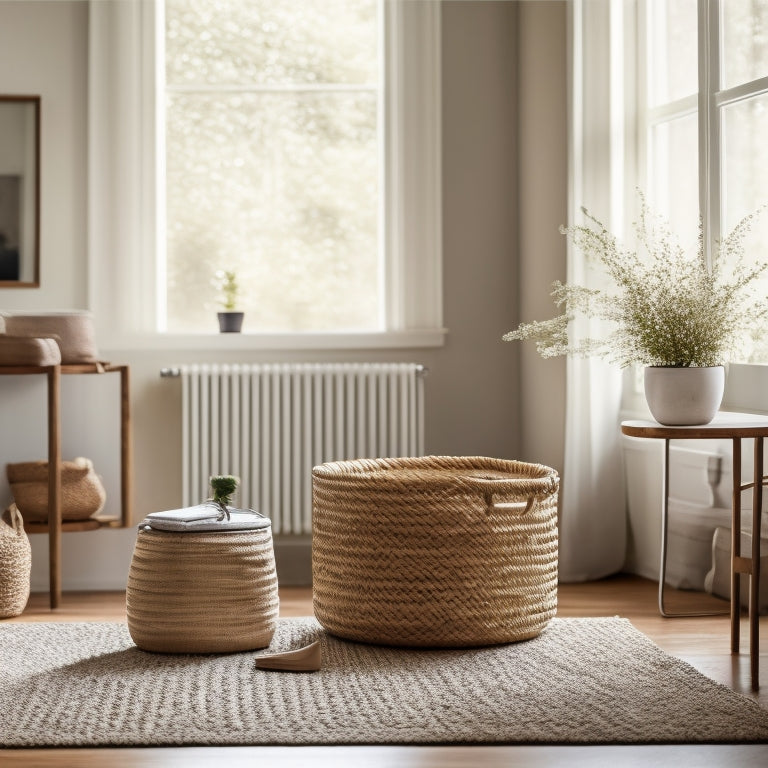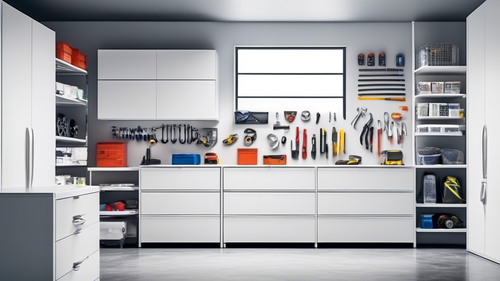
Budget-Friendly Decluttering Solutions for Homeowners
Share
You can change your cluttered spaces into organized oases on a budget by adopting simple yet effective strategies. Start by embracing a minimalist mindset, focusing on essentials, and repurposing items like vintage tea tins and old mason jars as functional organizers. Get creative with DIY storage hacks using cardboard boxes and containers, and maximize your vertical space with shelves and hooks. By implementing these solutions, you'll be surprised at how easily you can create a clutter-free zone that breathes new life into your home, and there's much more to investigate to take your organization to the next level.
Key Takeaways
- Adopt a minimalist mindset and focus on one area or task at a time to declutter effectively without breaking the bank.
- Repurpose household items like vintage tea tins, old mason jars, and worn-out t-shirts to create functional organizers and reduce waste.
- Utilize DIY storage hacks, such as transforming cardboard boxes and empty containers into labeled storage bins, to save money.
- Maximize vertical space by installing shelves, hooks, or floating shelves to keep items off the floor and create the illusion of more space.
- Implement a structured filing system and assign a home for each item to maintain organization and prevent clutter from building up again.
Decluttering on a Dime
Since you're ready to start decluttering, it's vital to understand that you don't need to break the bank to get organized. Embracing a minimalist mindset will help you focus on what's truly essential.
You can find affordable solutions at thrift stores, where clever finds can become functional organizers. Scour thrift store shelves for inexpensive baskets, bins, and containers to store your belongings.
Additionally, start with one area or task and implement a structured filing system to help you stay organized and focused. By doing so, you'll be able to evaluate your living spaces for functionality and optimize your storage and kitchen layout.
Repurpose old items, like turning an old mason jar into a desk organizer. With a little creativity, you'll be amazed at how far your budget can stretch.
Repurposing Household Items
Your grandmother's vintage tea tins, once filled with sweet treats, can now corral small office supplies or craft materials, breathing new life into a forgotten relic.
Repurposing household items is a budget-friendly way to declutter and create functional art. You can:
- Change old mason jars into pendant lights or vases for a touch of rustic charm.
- Upcycle worn-out t-shirts into reusable bags or cleaning rags, reducing waste and saving money.
- Convert cardboard tubes into desk organizers or craft supply holders, keeping your workspace tidy and organized.
DIY Storage Hacks
Now that you've breathed new life into old items, it's time to get creative with DIY storage hacks to keep your space organized and clutter-free.
Create homemade organizers using materials you already have at home, such as cardboard boxes, mason jars, and fabric scraps. Alter empty containers into storage bins by labeling and decorating them. Use affordable bins and baskets to store items like toys, linens, and cleaning supplies.
Repurpose old furniture, like an old ladder or bookshelf, to create unique storage solutions. With a little creativity, you can turn any space into a functional and clutter-free area.
Maximizing Vertical Space
Five feet of untapped storage space is hiding in every room - on your walls and ceilings. You can reclaim this space by maximizing your vertical storage.
Start by installing shelves or hooks to hang items like bikes, tools, or accessories.
Here are three ways to optimize your shelf organization:
-
Install floating shelves to create the illusion of more floor space while storing items like books, decorative items, or kitchenware.
-
Use wall-mounted storage units like cabinets, hooks, or baskets to keep items off the floor and out of the way.
-
Incorporate stackable containers to store items like linens, cleaning supplies, or toys, keeping them organized and accessible.
Creating a Clutter-Free Zone
What's standing between you and a clutter-free zone? It's likely a combination of bad habits and a lack of intentional organizing.
To create a clutter-free zone, start by conducting a space assessment to identify areas that need attention. Then, practice mindful organizing by categorizing items into three piles: keep, donate/sell, and discard.
Be ruthless – if you haven't used it in the past year, it's probably safe to let it go. Once you've purged your unwanted items, assign a home for each remaining item and commit to putting things back in their place.
Frequently Asked Questions
How Do I Stay Motivated During a Long Decluttering Process?
As you commence on this voyage, imagine each decluttered area as a guiding light, illuminating your path; celebrate decluttering milestones, track visual progress, and reward yourself to stay motivated, focused, and in control of your space.
Can I Declutter With Kids and Pets in the House?
You can declutter with kids and pets by implementing flexible decluttering strategies, involving children in the process, and creating a safe zone for pets, allowing you to maintain control and efficiency.
What if I'm Too Sentimental to Get Rid of Certain Items?
Are you really ready to let go of grandma's antique vase or your child's first drawing? You're not alone in feeling sentimental about certain items. Create a 'maybe' box for emotional attachments, and revisit them after 6 months - you might be surprised at what you're ready to release.
How Often Should I Declutter to Maintain a Clutter-Free Home?
You'll want to establish a decluttering schedule, dedicating time each week to maintaining your space, and prioritize seasonal maintenance to tackle specific areas, like winter closet organization or summer garage cleanouts, to keep your home clutter-free and in control.
Are Professional Organizers Worth the Investment for Extreme Clutter?
You're drowning in a sea of clutter, and a professional organizer's lifeline is tempting, but take a step back and do a cost analysis - their benefits, like customized systems and accountability, might be worth the investment for extreme clutter, but weigh the costs carefully.
Related Posts
-

Concealing Garage Storage: Tips for a Tidy Space
Are you ready to transform your chaotic garage into an organized haven? With a little planning and effort, you can...
-

3 Kitchen Hacks for a Clutter-Free Home
You can achieve a clutter-free kitchen by implementing three simple hacks: clear off countertops by designating spots...
-

10 Space-Saving Secrets for Cluttered Homes
You can banish clutter and breathe easy again by optimizing your home's vertical space with wall-mounted racks and sh...


